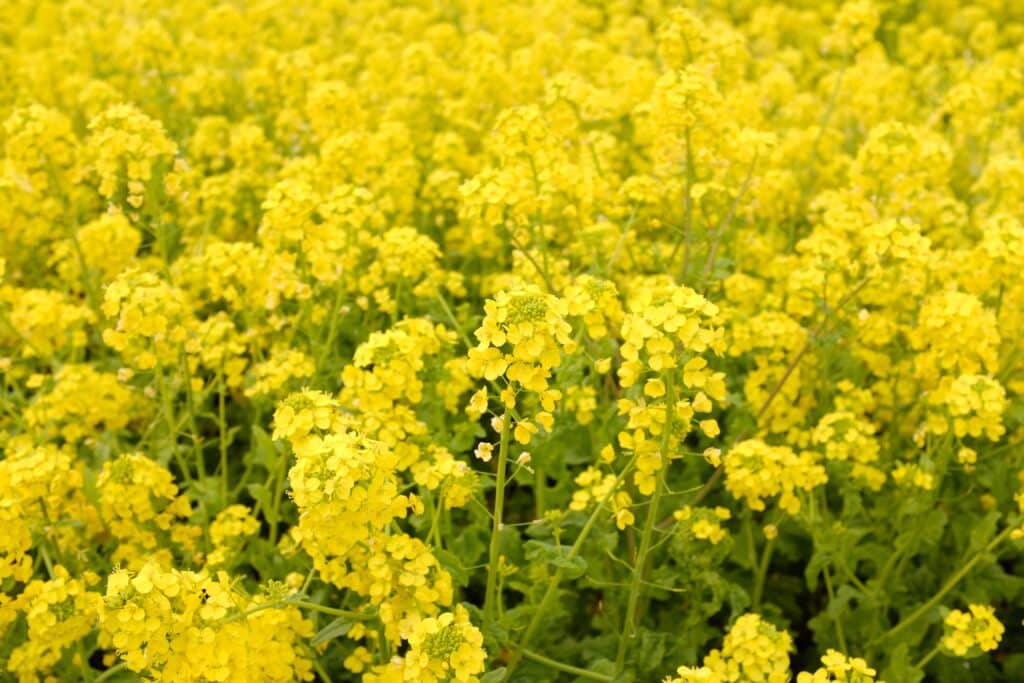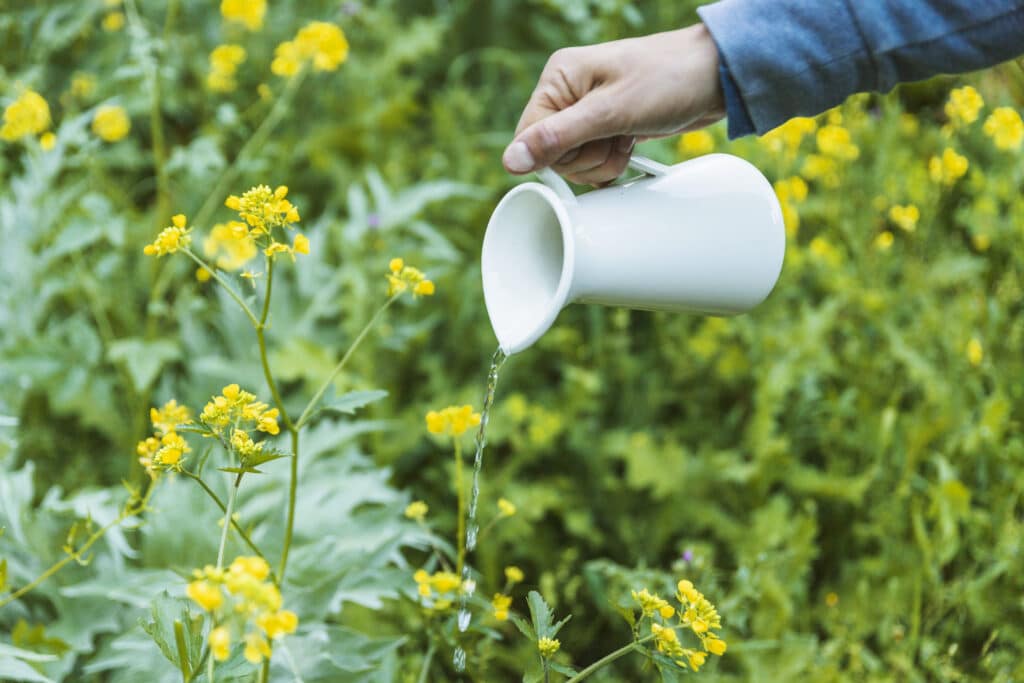How to Grow Goldenrod: Tips And Tricks
Gardening enthusiasts often seek vibrant blooms to enliven their autumn landscapes. With its showy yellow flowers, Goldenrod is a fall favorite for its beauty and ease of care.
This article will unfold valuable insights on cultivating and maintaining goldenrod, ensuring your garden becomes a hub for pollinators and a burst of late-season color. Delve in. The fall splendor awaits!
Key Takeaways
-
- Goldenrod, or solidago, has different types like Canada and Zigzag Goldenrod, which work well in many gardens.
-
- These plants are easy to take care of; they need sun and water once grown up and don’t usually want extra food (fertilizer).
-
- You can keep your goldenrod healthy by cutting it back in spring. This helps make more plants, too.
-
- If you don’t want goldenrod to spread too much, plant certain kinds or cut them back. Use edges or pots if needed.
-
- Watch for diseases like mildew on leaves and handle them quickly to keep plants strong.
Getting to Know Goldenrod

Goldenrod, also known as solidago, is a beautiful and popular perennial plant that blooms with bright yellow flowers in late summer. There are different types of goldenrod, each with unique appearance and smell.
Understanding these variations is important when choosing which type to grow in your garden.
Types of Goldenrod
Goldenrods light up gardens with their bright yellow flowers. They come from the Solidago genus, which includes many types perfect for your health-focused garden. Here’s a look at some types you can grow:
-
- Canada Goldenrod (Solidago canadensis): This tall plant often grows in wild meadows and is known for its long clusters of small yellow flowers.
-
- Rough Goldenrod (Solidago rugosa): It’s called rough because of its hairy stems. This type stands out with larger, more spaced-out flower clusters.
-
- Giant Goldenrod (Solidago gigantea): As it sounds, it’s one of the biggest kinds. The giant goldenrod lines stream banks with its showy blooms.
-
- European Goldenrod (Solidago virgaurea): Though not native to North America, this variety has made itself home here. Its smaller size makes it great for tighter spaces.
-
- Zigzag Goldenrod (Solidago flexicaulis): Named for its unusual stem shape, this one is perfect for shady spots in your garden.
Appearance and Smell
Goldenrod brightens a garden with its tall stems and golden-yellow flower heads blooming in clusters. These wildflowers stand out with their rich color when they bloom from late summer into fall.
Goldenrod plants are not just pretty; they also have a special scent. Their flowers smell sweet and spicy, like licorice or anise. Leaves give off their mix of smells, too—sometimes salty, sometimes like balsam.
This scent combo makes the goldenrod plant unique among native plants.
People often think goldenrod causes hay fever because it blooms simultaneously with ragweed, another plant that makes many sneeze and sniffle. But goldenrod pollen is too heavy to fly around in the air much—it doesn’t bother most folks’ allergies.
So it’s safe to add these pretty yellow blooms to your garden without worrying about hay fever!
How to Grow and Care for Goldenrod
Growing goldenrod requires a planting location with full sun and well-drained soil. Water regularly and fertilize in the spring for optimum growth. Pruning and propagation can help maintain healthy plants.
Planting Location
Choose a sunny spot for your goldenrod since it loves full sun. Make sure the soil drains well, too. It will grow better if you pick a plant right for your area. Goldenrods are not picky and can grow in places like meadows and gardens.
But each type likes different soil, so find out which one is best for where you live. For example, the Canadian Goldenrod grows well in soil with some clay and likes it moist but not too wet.
Put your goldenrod where butterflies can easily find it because these plants attract them. Planting near other late bloomers helps feed these helpful insects when there’s not much else to eat.
The flowers also call over bees that help all the plants in your garden by pollinating them.
Watering and Fertilizing

Goldenrod plants are drought-tolerant, so they usually don’t need much watering once established. Overwatering can lead to problems, so water only if there’s little rainfall.
- Minimal Watering: Once established, mature goldenrod plants typically need little to no watering.
- Drought Tolerance: Goldenrod is well-adapted to dry conditions and does not require frequent watering.
- Avoid Overwatering: Water sparingly, especially in well-drained soil or during periods of regular rainfall.
- Fertilizing Cautions: Avoid over-fertilizing as it can cause floppy growth and lessen the number of flowers.
- Fertilizer Not Necessary: Goldenrod generally does not require fertilization and can thrive without additional nutrients.
Pruning and Propagation
Pruning and propagating goldenrod is crucial for maintaining healthy plants. Here are some tips for successful pruning and propagation:
-
- Regular pruning is essential to prevent goldenrod plants from becoming too leggy and encourage bushier growth. Ensure that you cut back the plant during late spring to promote healthy growth.
-
- Clumps of goldenrod need division every four to five years. Cuttings can also be taken and planted in the garden to propagate new plants, promoting the diversity of goldenrod species.
-
- Cutting propagation of woody goldenrod can be easily accomplished with terminal stem cuttings, particularly from summer softwood, ensuring successful growth of new plants with minimal effort.
-
- When a clump of goldenrod encroaches on other plants, outer stems can be removed to control aggressive spreading and maintain a harmonious garden environment.
Common Issues and Solutions
Goldenrod can be quite resilient, but there are common issues to look out for, such as aggressive spreading or leggy growth. Controlling these problems and finding effective solutions will ensure your goldenrod thrives in your garden.
Controlling Aggressive Spreading
- To control the aggressive spreading of Goldenrod in your garden, consider these tips:
- Plant clump-forming types of Goldenrod to limit aggressive growth and prevent smothering other plants in your garden or prairie.
- Monitor and prune rhizomatous types to prevent excessive spreading and maintain a more controlled growth pattern.
- Utilize physical barriers like deep edging or containers to contain the spread of aggressive goldenrod species in your garden beds.
- Implement targeted herbicide applications as a last resort for managing particularly invasive goldenrod varieties, ensuring proper identification and carefully following label instructions.
- Encourage the growth of native prairie plants that can compete with goldenrod, helping to naturally limit its spread and dominance in the ecosystem.
Dealing with Leggy Growth
Goldenrod plants can become leggy and flop if grown in rich soil. Regular pruning can prevent goldenrod plants from becoming too leggy and encourage healthy growth. Insufficient light is the number one cause of leggy seedlings, so providing more light can help prevent this issue. It is important to be proactive in preventing floppy perennials, as once the plants have fallen over, little can be done to restore them.
-
- Provide Adequate Sunlight: Ensure goldenrod plants receive sunlight or light shade to promote strong and upright growth.
-
- Moderate Fertilization: Avoid excessive fertilization, as it can lead to overly lush foliage, causing the plant to become top-heavy and flop over.
-
- Proper Spacing: Plant goldenrod at appropriate intervals to allow for adequate airflow and reduce resource competition, preventing leggy growth.
-
- Regular Pruning: Trim back the stems by one-third in late spring to early summer to promote bushier growth and prevent legginess.
-
- Provide Support if Necessary: Stake or use other forms of support for tall varieties to keep them upright and prevent flopping.
-
- Optimal Watering: Water goldenrod plants deeply but infrequently to encourage deep root growth and sturdy stems.
-
- Monitor Soil Nutrients: Regularly test soil fertility and adjust nutrient levels to prevent excessive vegetative growth leading to legginess.
Final Tips
Choose a site with well-draining soil and plenty of sunlight when planting goldenrod. This plant can thrive in dry conditions and attracts beneficial pollinators such as butterflies and bees.
Goldenrod also offers potential health benefits due to its traditional medicinal uses, particularly for respiratory health support. Incorporating goldenrod into your garden contributes to the local ecosystem and enhances your well-being.
Keep an eye out for any signs of powdery mildew or rust on the leaves, as early detection can prevent these common issues from affecting the plant’s growth.
Consider starting with goldenrod cultivars with less aggressive spreaders if you have limited space or prefer more controlled growth. These cultivars still provide beautiful blooms without posing the same invasiveness concerns as some wild species.
Lastly, avoiding watering the foliage directly is crucial to minimize the risk of disease development. With proper care and consideration, adding goldenrod to your garden can be a rewarding experience both aesthetically and potentially even medically.
FAQs
Q: What are some tips for growing goldenrod in the garden?
A: To grow goldenrod in your garden, ensure the soil conditions are right, as they prefer well-drained, fertile soil and plenty of sunlight. Goldenrod is easy to grow and is drought-tolerant once established.
Q: How do I propagate goldenrod plants?
A: Goldenrods can be propagated from seeds, rhizomes, or by division. You can sow seeds in late fall or early winter, while rhizomes can be divided in late winter or early spring.
Q: What are some common varieties of goldenrod?
A: There are various cultivars and species of goldenrod, including Solidago canadensis, Solidago rugosa, and Solidago nemoralis, each with unique characteristics and growing requirements.
Q: Can goldenrod be a problem for hay fever sufferers?
A: Contrary to popular belief, goldenrod does not cause hay fever. Its pollen is not airborne and is mainly carried by insects, so it is generally not a major source of allergens.
Q: How do I care for goldenrod blooms?
A: To care for goldenrod blooms, deadhead the flowers to encourage more blooms and prevent self-seeding. You can also cut the flowers for indoor arrangements to enjoy their bright yellow color.
Q: What are some ways to attract pollinators using goldenrod?
A: Goldenrod is a great pollinator plant and attracts various beneficial insects. Planting goldenrod in your garden can help support local pollinator populations and contribute to a healthy ecosystem.
Q: How do I grow goldenrod from seed?
A: To grow goldenrod from seed, sow the seeds outdoors in late fall or winter. Depending on the species, seed heads can be collected and sown directly into the soil where you want the goldenrod to grow.
Q: Are there any precautions to take when planting goldenrod due to its spreading nature?
A: Goldenrod can spread aggressively, so it’s important to consider its growth habits when planting. You can contain its spread by planting it in areas with room to expand or through regular division of the plants.
Q: What are the ideal growing conditions for goldenrod?
A: Goldenrods grow best in dry, sandy soil and thrive in meadows, prairies, and open woodlands. They are also tolerant of drought conditions once established.
Q: Why should I consider planting goldenrod in my garden?
A: Goldenrod offers bright yellow flowers, is easy to grow, and attracts pollinators, making it a valuable addition to any garden. It is also a native wildflower that adds vibrancy and biodiversity to the landscape.

